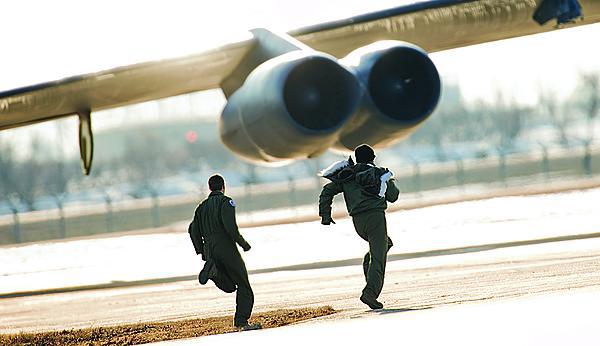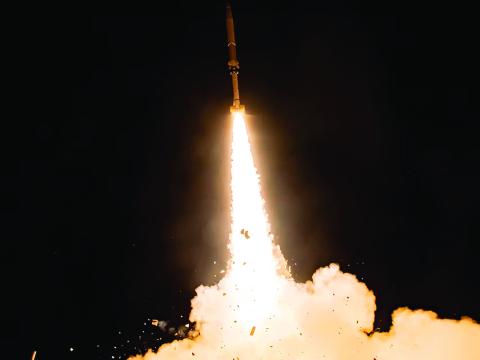Modernizing Nuclear Bomber Command and Control
U.S. Air Force officials are working to replace by 2019 aging command and control terminals that are part of the U.S. Air Force’s nuclear bomber mission. The new terminals will communicate with advanced satellite constellations and also will add capabilities not in current systems.
The Global Aircrew Strategic Network Terminal (Global ASNT—pronounced global assent) is a ground-based, three-increment program that provides persistent, survivable and redundant command and control (C2) communications to the U.S. Air Force strategic bomber fleet. The terminals also provide a C2 capability for the tankers and intelligence, surveillance and reconnaissance aircraft supporting the nuclear bomber mission. It is a part of the Minimum Essential Emergency Communications Network (MEECN) that passes messages from national command authorities—the president and senior leaders—to nuclear forces.
The program will provide 45 fixed communication terminals for sites such as wing command posts, along with 45 transportable terminals to support dispersed operations. The first increment of the program will provide advanced extremely high frequency (AEHF) communications compatible with the new AEHF satellite constellation and will replace legacy Military Strategic Tactical Relay (MILSTAR)-compatible terminals. The AEHF constellation will be the military’s primary satellite system for highly protected communications following the launch of the fourth and final satellite in 2017.
The new AEHF terminals are required because of projected end-of-life issues with the MILSTAR satellite constellation and looming obsolescence of the currently fielded terminals. “It replaces unsustainable legacy systems. Some of the systems it replaces are getting toward the end of their life cycle, and they’re difficult to maintain,” says Lt. Col. Kenneth Decker, USAF, Global ASNT program manager. “It’s like when your car gets to the point where it costs too much to maintain it.”
The Global ASNT program office focuses on engineering and sustaining nuclear C2 terminals. Secure, survivable ground terminals at wing command posts receive emergency action messages. Those messages then are disseminated to bomber, tanker and reconnaissance aircrews for action.
Global ASNT Increment 1 replaces the Single-Channel, Anti-Jam, Man-Portable system, which was fielded in 1998. Increment 2 replaces two systems, the Aircrew Alerting Communication Electromagnetic Pulse and the Electromagnetic Hardened Dispersal Communications systems, which were fielded in 1988 and 1989, respectively. Because Increment 3 is a new capability, it is not replacing older systems.
Increment 1 entered the engineering and manufacturing development phase late last year with the award of a potentially $500 million contract to Raytheon. The initial segment focuses on receiving messages by establishing a secure communication path with satellites using extremely high frequency (EHF) waveforms. The new systems will be compatible with the existing MILSTAR satellite system as well as the new AEHF satellites. Col. Decker describes the replacement of MILSTAR satellites as the primary driver behind Global ASNT. “The legacy system that receives the emergency action messages is unable to communicate with that new satellite constellation. The Air Force, the Navy and the Army are fielding new terminals to communicate with that new constellation,” he reports.
The first increment is the only portion of the program funded so far. It is expected to reach preliminary design review in the fall of this year and critical design review next spring. The initial operating capability should be available in 2018, and Air Force officials are shooting for full operational capability the following year. “This is an aggressive schedule. We need to field this system by 2019,” Col. Decker asserts.
Increment 2 will focus on distribution of emergency action messages to aircrews via pagers, radios and loud warning klaxons. The program manager does not completely rule out the possibility that warning messages one day could be sent to mobile devices, but he indicates that current mobile platforms are probably not practical. “This is a nuclear command and control terminal, so it would have to be radiation hardened and survivable, meaning electromagnetic pulse protected. If an electromagnetic pulse were to occur, it would fry most electronic systems,” he explains. “I don’t know if the cellphone or tablet technology currently exists to meet those requirements. That would be something the contractor for Increment 2 would take into consideration for its design.”
The second increment also will add new capabilities not found in legacy systems. “In addition to the ultrahigh frequency radios that are used, we’re providing high frequency communication capability,” he adds.
Increment 3 will provide a redundant capability for emergency action message reception via very low frequency waveforms. “Currently, in the bomber command post, they don’t have that redundant capability. This is nuclear command and control. It’s important for the president and senior leaders to maintain communication with the nuclear bomber fleet,” Col. Decker asserts. “It’s critical, in the event of certain scenarios, that information is communicated to the operational folks who will accomplish the mission.” The three segments will be competed separately, meaning a new contractor could be brought on for each portion of the program. The strategy allows the Air Force to pick the best contractor for each leg of the program, depending on the technologies and capabilities required, Col. Decker indicates. “Making sure that we have created a low-risk acquisition strategy has had some challenges as far as refining requirements, but we’ve been able to do that,” he states.
To lower risks on the program, the program office has worked hand in hand with the operational users, including Air Force Global Strike Command, Air Combat Command, Air Mobility Command, U.S. Air Forces in Europe and the Air National Guard and Reserve. The program also is leveraging technology from other programs, including Army and Navy systems. Using lower-risk technologies rather than building everything from scratch allows the program office to also use a fixed-price incentive firm type contract for Increment 1 rather than a cost plus award fee approach. “We’re taking advantage of other systems that have either already started development or are in the process of fielding. All of these are new advanced EHF terminals, and we felt the technology is there so that we can take advantage of this type of a contract and the hardware and software from these other systems,” Decker offers.
Assuming the next two increments are funded, the next award likely will not occur before 2016, he projects. “If funding is delayed, then the Air Force is going to have to come up with funds and ways to keep these legacy systems in the field longer than their life cycle,” the colonel warns. “But other than the cost, it’s also the mission. The nuclear command and control mission is very important to our nation. This program is a priority for Air Force Global Strike Command and the users, and they’re looking to fund the system.”
The colonel cites sequestration and recent government shutdowns as challenges the program has encountered. Other challenges may yet occur. “This is new technology with a new satellite constellation, so there may be some technological things that we have to work through,” he allows.
The Global ASNT program replaces the Ground Element MEECN System program, which was terminated for convenience in 2011. That program had awarded one contract for all phases. Global ASNT was started the same year with the three-increment approach.
“Basically, the program was over cost and behind schedule, so the Air Force decided to cancel it, to re-look at the requirements and to stand up Global ASNT,” the colonel recalls. “We’re confident that our acquisition strategy and the requirements that we’ve levied against the system are well defined and that we’ll be successful.”






Comments